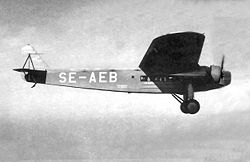Fokker F.VIII
| Fokker F.VIII | |
|---|---|

|
|
| Type: | Twin-engine airliner |
| Design country: | |
| Manufacturer: | |
| First flight: |
March 12, 1927 |
| Commissioning: |
June 1927 |
| Production time: |
1927- |
| Number of pieces: |
11 |
The Fokker F.VIII was a twin-engine, high- wing airliner designed by the Dutch manufacturer Nederlandsche Vendunguigenfabrieken in the 1920s. It offered space for up to fifteen passengers. Most of the few copies built came into the possession of the KLM airline .
history
In 1926, KLM needed a passenger aircraft with a higher capacity than the Fokker F.VII used up to now . In the same year, Fokker's head of development Reinhold Platz began developing the F.VIII .
The starting point was the design of the unsuccessful, single-engine FV from 1922. In order to increase flight safety, the new type was to be equipped with three water-cooled engines. The availability of new air-cooled drives made it possible to reschedule to a twin-engine aircraft.
The prototype made its maiden flight on March 12, 1927. In the same year, delivery to KLM began. In the following years more aircraft were built for the Hungarian Malert , mostly under license in Hungary.
In July 1927, Fokker designed the F.VIIIw , a seaplane that could be used as a bomber with a machine gun in the bow. Due to a lack of demand, a prototype was not built.
construction
The fuselage of the F.VIII had a frame made of welded steel tubes and a cladding made of plywood, fabric and duralumin . The wings of the cantilever high-decker were made of wood covered with fabric. The closed cockpit initially only had a single front window. Later, additional side openings were built into some machines.
The nacelles of the two engines were under the wings. The originally planned bow motor was replaced by an additional cargo compartment in front of the cockpit.
Most of the machines were delivered with two Bristol Jupiter star engines and two-bladed propellers. The models used by Malert had the almost identical but somewhat more powerful Jupiter engine from Gnome-Rhône and a four-blade propeller. The KLM aircraft were retrofitted with two Pratt & Whitney Wasp D1T1 engines, which were now attached to the leading edge of the wings.
use
Seven aircraft were delivered to KLM from June 1927. One of the aircraft came into the possession of the Hungarian airline Malert in 1928, which later had three more aircraft built by the Hungarian manufacturer Manfred Weiss . One of them was handed over to the Hungarian armed forces in 1938 and converted into a bomber.
In 1936 KLM sold two aircraft to British Airways , a third went to Venezuela in 1937, a fourth to the Swedish ABA in 1934, and in 1939 as Tp 10 to the Swedish Air Force. A machine sold by KLM to British Airways in 1937 was first used by the Swedish company GA Flygrender from 1939, and then by the Finnish Air Force. In September 1941 it was lost in a crash landing. Another KLM machine was owned by the Dutch armed forces from 1937.

Users
Civil users
Military users
- Swedish Air Force (Tp 10)
Technical specifications
| Parameter | Data |
|---|---|
| crew | 2 pilots, 1 flight attendant |
| Passengers | 10-15 |
| length | 16.80 m |
| span | 23 m |
| height | 4.20 m |
| Wing area | 82 m² |
| Empty mass | 3350 kg |
| Takeoff mass | 5800 kg |
| Cruising speed | 180 km / h |
| Top speed | 210 km / h |
| Service ceiling | 5500 m |
| Range | 1100 km |
| Engines | two air-cooled radial engines Bristol Jupiter IV with 294 kW (400 PS) each |
See also
Web links
- www.dutch-aviation.nl Pictures and information on dutch-aviation.nl (English)
- Pictures and information on aviastar.org (English)
Individual evidence
- ↑ Number of items Source: Fokker F.VIII (engl.)

